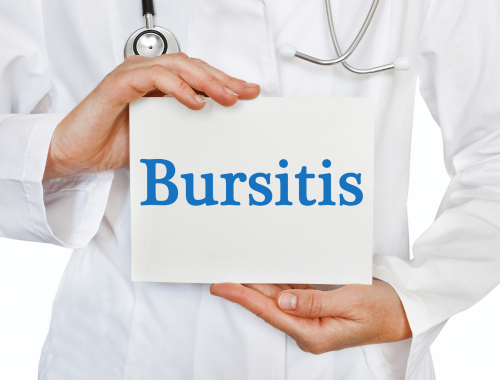Difference Between Sciatica and Bursitis
Sciatica is the nerve pain that occurs along the sciatic nerve course down to the legs. It starts with lower back pain which radiates down to lower limbs. Bursitis is a tender painful swelling of the space around the joint.

What is sciatica?
Definition:
Sciatica is the nerve pain that occurs along the sciatic nerve course down to the legs. It starts with lower back pain which radiates down to lower limbs.
Causes:
Sciatica can occur in a variety of conditions. These include disc herniation, osteoarthritis, tumors in lower vertebrae, spinal canal compression, trauma to backbone spondylolisthesis, piriformis syndrome, and cauda equina syndrome.
Symptoms:
Sciatica presents as lower back pain involving the buttocks and moving down to the leg and calf. The pain increases with leg movement. Sometimes a serious condition called cauda equina can occur which causes numbness around the buttocks and loss of bladder and bowel function along with sciatica.
Diagnosis:
History is key to diagnosing sciatica. On examination, a straight leg test is usually performed to identify sciatica. Important investigations include spinal X-rays, MRI scans, and nerve conduction velocity studies.
Treatment:
Symptomatic relief for sciatica can be achieved via the use of ice packs, mild physical exercises, and nonsteroidal anti-inflammatory drugs(NSAIDs. Medical management of sciatica includes drugs like cyclobenzaprine, tricyclic antidepressants, and spinal steroid injections. Physiotherapy is an important component of treating sciatica.

What is Bursitis?
Definition:
Bursitis is a tender painful swelling of the space around the joint.
Causes:
Repetitive movements like heavy weight lifting and persistent kneeling can apply pressure on the joints and lead to bursitis. Rarely infections can result in bursitis. Certain activities increase the chance of getting bursitis, these include gardening, painting, bad posture, playing sports like tennis and baseball, and shoveling.
Symptoms:
Symptoms of bursitis include painful movement of the joint, restricted movement of the joint, redness, and tenderness over the affected joint, and fever or chills in case of infection.
Diagnosis:
Bursitis is diagnosed after a physical examination and investigations like X-rays, Ultrasound, MRI scan, and sometimes joint fluid aspiration are carried out.
Treatment:
At-home treatment for bursitis involves using icepacks over the tender joints, use of NSAIDs, applying heat over the affected region, and wearing a splint. The doctor might prescribe antibiotics in case of infection, give a steroid injection in joints, and may refer to physiotherapy to help with joint movement. Rarely surgery might be needed to remove the bursa.
Difference between Sciatica and Bursitis
Definition:
Sciatica is the nerve pain that occurs along the sciatic nerve course down to the legs. It starts with lower back pain which radiates down to lower limbs. Bursitis is a tender painful swelling of the space around the joint.
Causes:
Sciatica can occur in a variety of conditions. These include disc herniation, osteoarthritis, tumors in lower vertebrae, spinal canal compression, trauma to backbone spondylolisthesis, piriformis syndrome, and cauda equina. Repetitive movements like heavy weightlifting and persistent kneeling can apply pressure on the joints and lead to bursitis. Rarely infections can result in bursitis. Certain activities increase the chance of getting bursitis, these include gardening, painting, bad posture, playing sports like tennis and baseball, and shoveling.
Symptoms:
Sciatica presents as lower back pain involving the buttocks and moving down to the leg and calf. The pain increases with leg movement. Sometimes a serious condition called cauda equina can occur which causes numbness around the buttocks and loss of bladder and bowel function along with sciatica. Symptoms of bursitis include painful movement of the joint, restricted movement of the joint, redness, and tenderness over the affected joint, and fever or chills in case of infection.
Diagnosis:
History is key to diagnosing sciatica. On examination, a straight leg test is usually performed to identify sciatica. Important investigations include spinal X-rays, MRI scans, and nerve conduction velocity studies.
Bursitis is diagnosed after a physical examination and investigations like X-rays, Ultrasound, MRI scan, and sometimes joint fluid aspiration are carried out.
Treatment:
Symptomatic relief for sciatica can be achieved via the use of ice packs, mild physical exercises, and nonsteroidal anti-inflammatory drugs(NSAIDs. Medical management of sciatica includes drugs like cyclobenzaprine, tricyclic antidepressants, and spinal steroid injections. Physiotherapy is an important component of treating sciatica. At-home treatment for bursitis involves using icepacks over the tender joints, use of NSAIDs, applying heat over the affected region, and wearing a splint. The doctor might prescribe antibiotics in case of infection, give a steroid injection in joints, and may refer to physiotherapy to help with joint movement. Rarely surgery might be needed to remove the bursa.
Table of difference between Sciatica and Bursitis

FAQs
Does bursitis feel like sciatica?
No.
How do you know if you’ve got bursitis?
Symptoms of bursitis include painful movement of the joint, restricted movement of the joint, redness, and tenderness over the affected joint, and fever or chills in case of infection. Bursitis is diagnosed after a physical examination and investigations like X-rays, Ultrasound, MRI scan, and sometimes joint fluid aspiration are carried out.
What is the treatment for bursitis and sciatica?
Initial treatment options for sciatica include self-care treatment such as applying ice packs, taking nonsteroidal anti-inflammatory drugs(NSAIDs), and performing mild exercises. At-home treatment for bursitis involves using icepacks over the tender joints, and use of NSAIDs. The doctor might prescribe antibiotics in case of infection, give a steroid injection in joints, and may refer to physiotherapy to help with joint movement. Rarely surgery might be needed to remove the bursa.
What can be mistaken for bursitis?
Soft tissue injuries or tendon injuries.
Does bursitis hurt all the time?
It may or may not be symptomatic.
Why did I suddenly get bursitis?
It can be due to injury or infection.
- Differences Between Reptiles and Amphibians - May 17, 2024
- Difference Between Ophthalmology and Optometry - May 15, 2024
- Difference Between Fear and Anxiety - April 2, 2024
Search DifferenceBetween.net :
Leave a Response
References :
[0]Tarulli, Andrew W., and Elizabeth M. Raynor. "Lumbosacral radiculopathy." Neurologic clinics 25.2 (2007): 387-405.
[1]Valat, Jean-Pierre, et al. "Sciatica." Best practice & research Clinical rheumatology 24.2 (2010): 241-252.
[2]Aaron, Daniel L., et al. "Four common types of bursitis: diagnosis and management." JAAOS-Journal of the American Academy of Orthopaedic Surgeons 19.6 (2011): 359-367.
[3]Image credit: https://www.canva.com/photos/MAFhFSuvMbE-woman-suffering-from-lower-back-pain-spreading-to-sciatica-pain-concept/
[4]Image credit: https://www.canva.com/photos/MADFZ0Y0tfM-bursitis-card-in-hands-of-medical-doctor/
